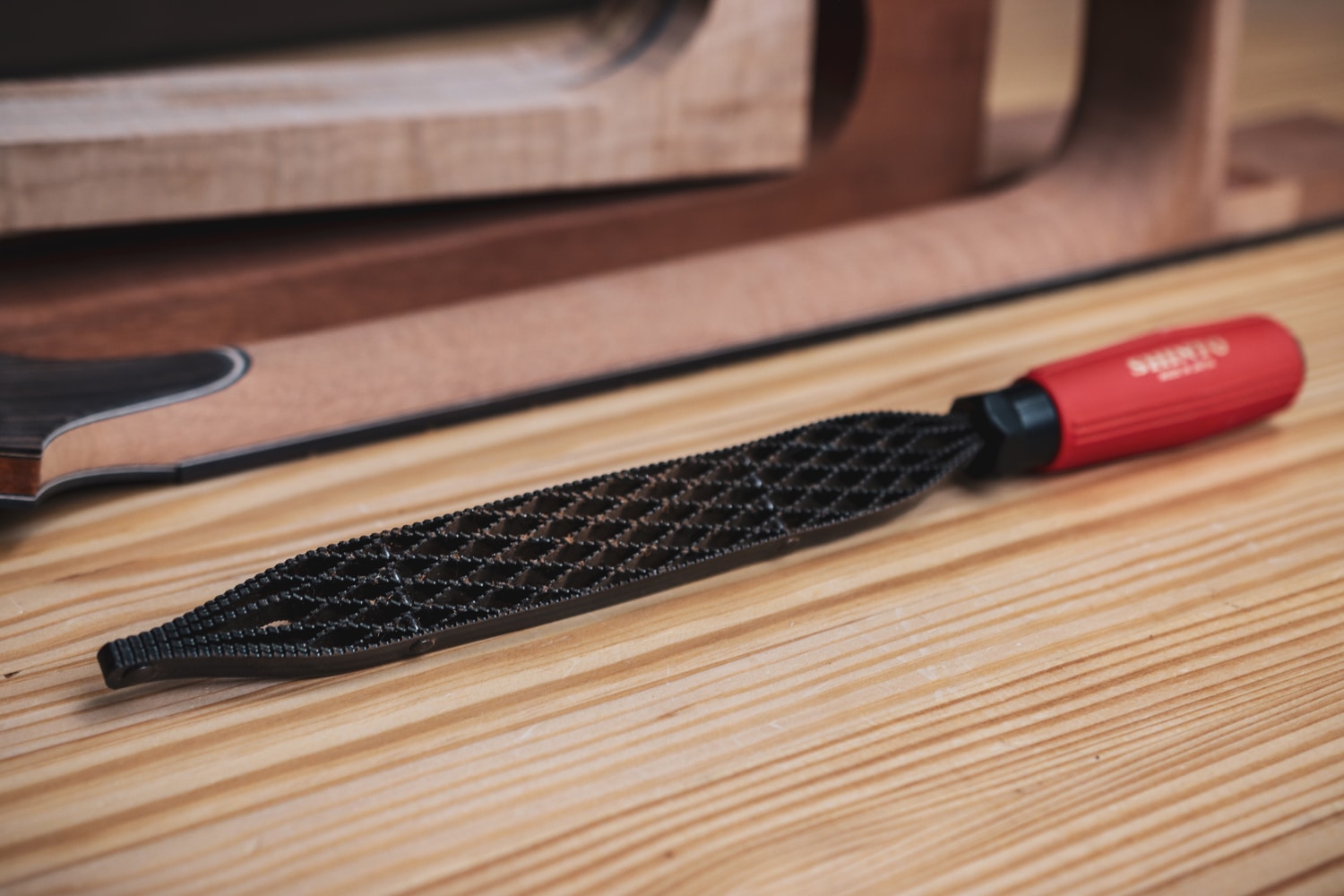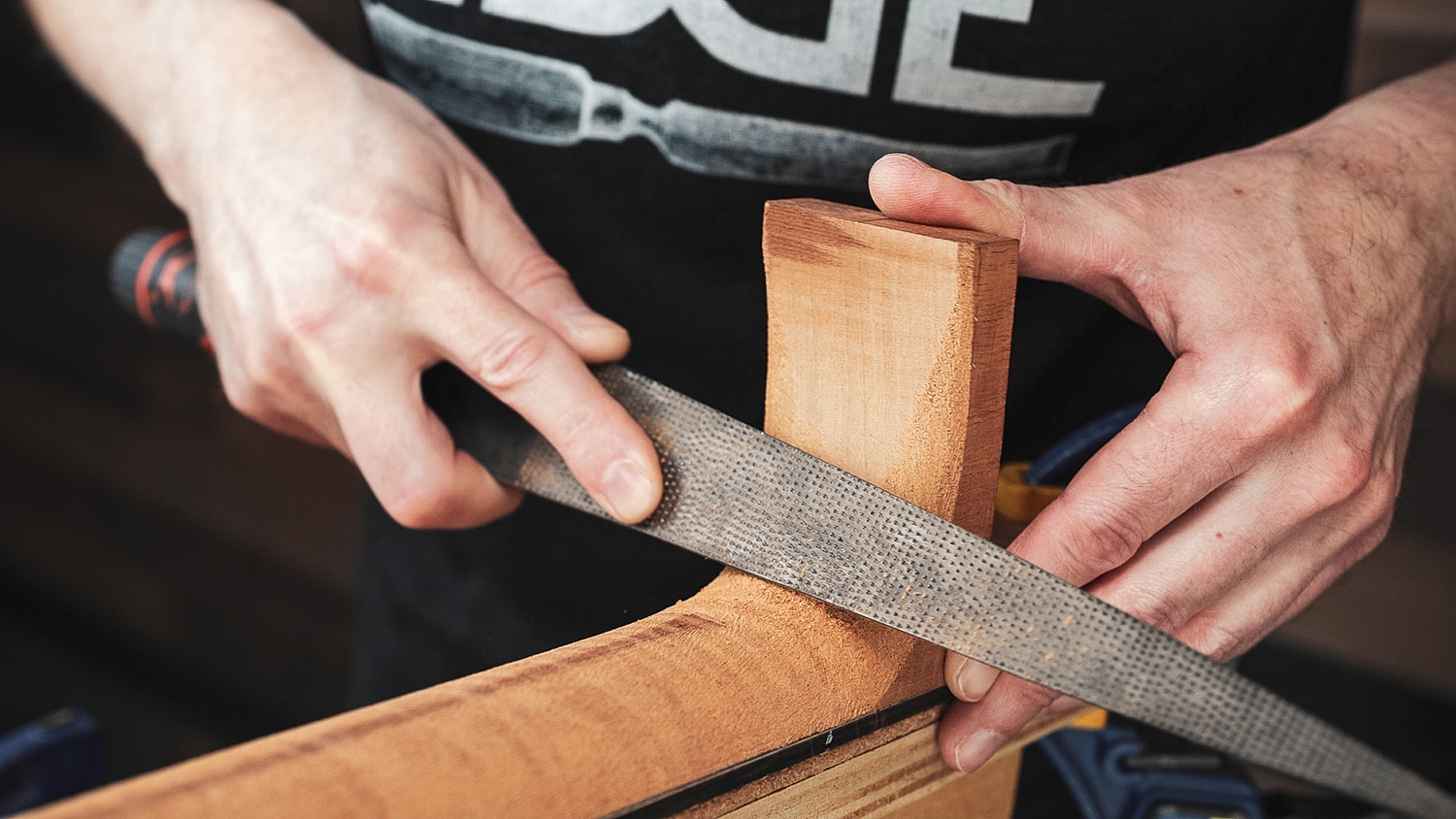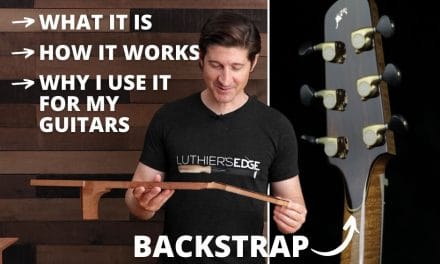What is the best wood rasp for guitar making? Well, if you’ve watched the video above or the one over on our Art Of Lutherie YouTube Channel, you already know what my favorite rasp for guitar making is. But, you might also know that is a very personal choice. If you’re interested in learning more about how I found that perfect tool and, more importantly, how you can find the perfect rasp for you and your guitar-making style, this article is for you; I hope you find it helpful!
Finding the best wood rasp for guitar neck-shaping and other guitar-making tasks is not just a matter of finding the highest-quality tool but, rather, finding one with the right mix of features that will help you feel more comfortable and confident as you work.
This extra confidence and comfort, at least for me anyway, results in a more creative and enjoyable experience and, ultimately, better results with fewer mistakes. The key to finding that sweet spot is in finding the rasps that will match your personal preferences and your style of working.
So, how do you find this perfect rasp? Well, you could just try some different rasps and see how it goes, but that would take a lot of time and a lot of money. My goal is to help you skip all the trial and error that I went through and to guide you—right here in this article—through choosing a rasp that best fits your style of working and your guitars.
But before I get into my story of the different rasps I have used over the years to make my guitars, which rasp I like the best right now, and why I like it so much, let’s take a few seconds and make sure we are all on the same page here when we are discussing wood rasps and their basic features.
Table Of Contents
What Is A Wood Rasp & What Is The Difference Between A Rasp & A File?
What is a rasp? A rasp is similar to a file but with a few key differences, the most important of which is the rasp’s teeth.
Rasps have individually cut teeth, and files have parallel rows of teeth. As a result of the difference in teeth, rasps are much more aggressive in how they cut the wood fibers.
This aggressive cut allows us to remove wood faster than we could with files, but it also leaves much deeper scratches and a rougher surface than files. For a more technical definition of rasps, you can check out this article , but I think that covers it for our purposes here. Onward!
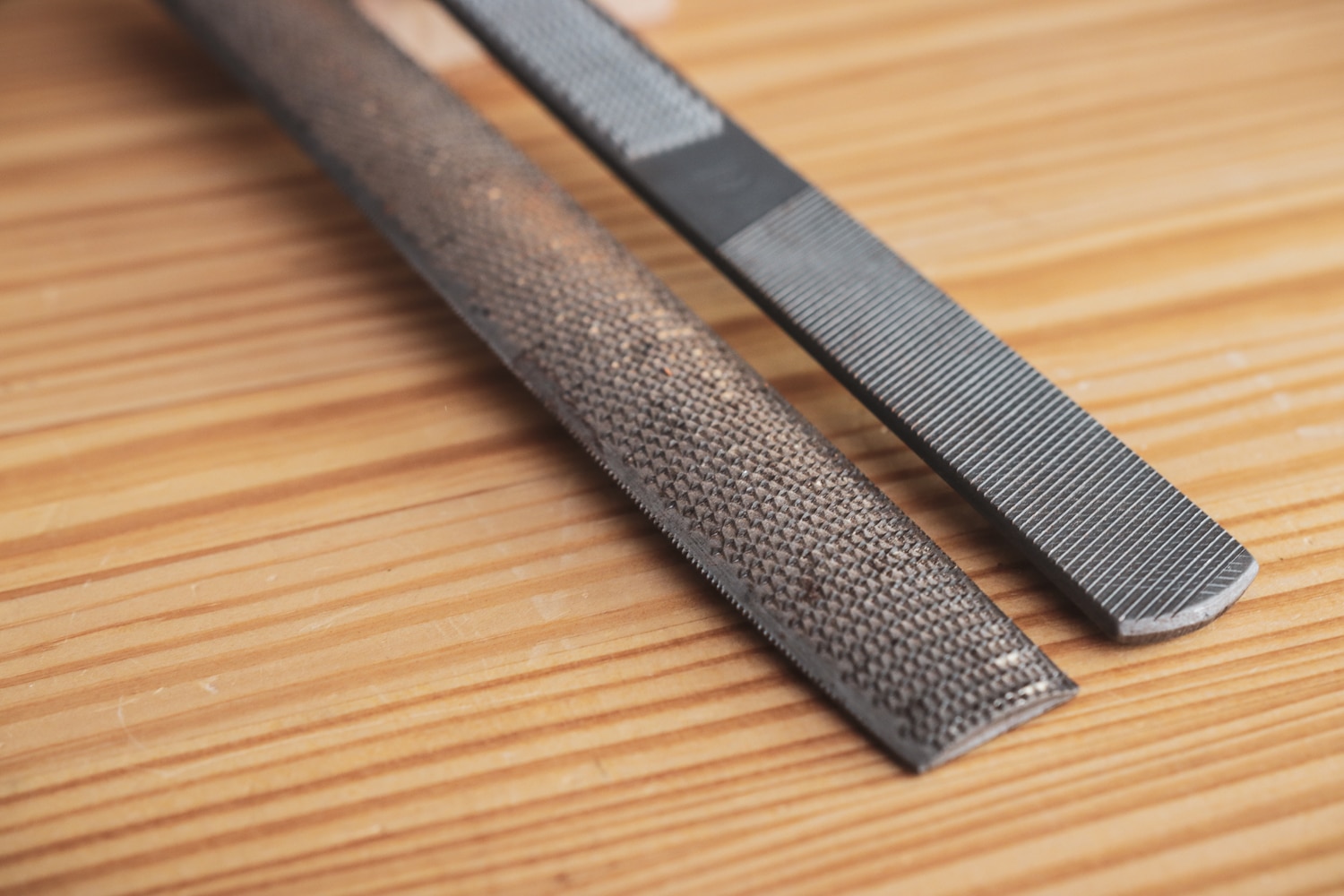
Basic Elements Of Wood Rasps
Next, let’s look at some basic components and features that you’ll need to be thinking about when choosing the perfect tool for your style and your work. Below is a list of the main elements of rasps, each with a brief description and a few thoughts to keep in mind as to how those elements may affect your intended uses. The important point to remember is that, rather than looking at this from the perspective of one element or feature being “better” than another, I recommend focusing on identifying the elements or features that will best suit your personality, working style, and applications.
Let’s begin by looking at the list of different elements or features to consider.
1 – Rasp Length:
A longer rasp is great for larger areas and also for removing more wood faster, due to its longer cutting surface. This enables a longer cutting stroke to take off more wood with each pass. A shorter rasp is good for working in smaller areas where a long cutting stroke isn’t needed, and also where a longer tool might risk scraping other nearby areas of the guitar or workpiece.2 – Rasp Shape:
A straight-sided rasp will provide a uniform cutting experience, which can be good for uniform surfaces, as in furniture-building. A tapered rasp shape can offer much more versatility. The smaller, more tapered end can allow for access into smaller areas and is great for blending operations when making a graceful transition from one contour to another is needed. This is especially helpful for carving a guitar neck, as we blend the transitions of the main neck area to the heel or the headstock.
3 – Rasp Width:
I find that a wider rasp helps me make a more constant surface, but the wider rasp will also limit the usefulness of the tool on smaller surfaces. This is why I prefer the tapered shape that I mentioned above. It can have a wide base to use for more open and larger surfaces, and then the middle or end of the rasp can be used to get into smaller areas and counters. If you’re using straight rasps, you will need more individual tools of different widths for the different-sized areas of the guitar neck.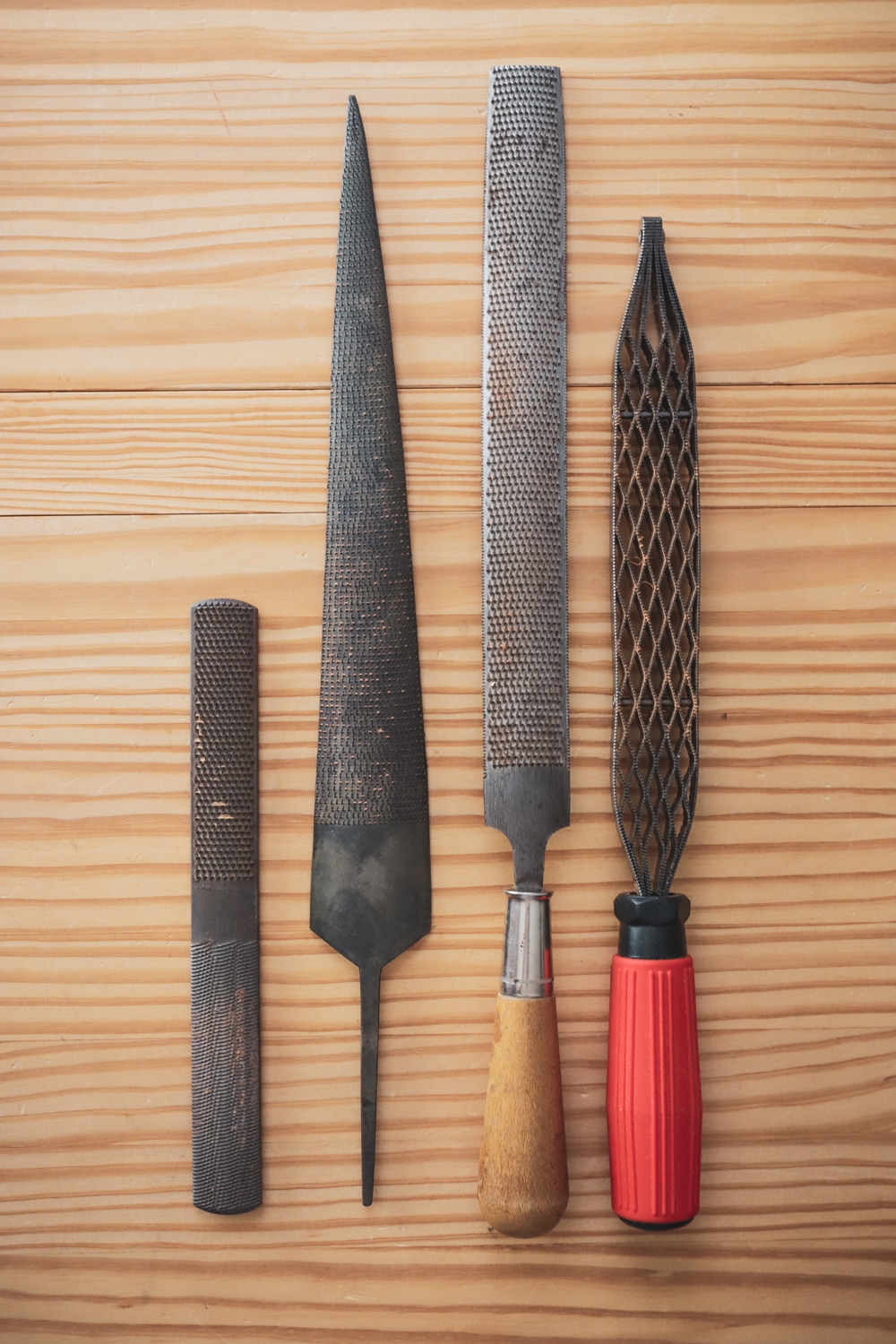
4 Cross-Section Shape:
When it comes to carving a guitar neck, and for most general woodworking purposes, the most popular rasp and file cross-section is the half-round profile. It is flat on one side and has a radius on the other side. Some rasps may have a more severe radius on the “round side” than others. Here again, the tapered shape is a great feature because, many times, the radius side will have a radius that gets tighter as it moves up toward the tip of the rasp. This provides you with many different radii to utilize for blending and countering more complex surfaces and contours of different sizes. If the rasp is straight-sided, you most often will have a single radius or curve from end to end on the “round side” of the tool.5 Aggressiveness Of Cut:
A more coarse tooth will remove wood very quickly, while leaving behind a very rough surface with deep scratches in the remaining wood that will need to be removed in later steps. A fine tooth will remove wood less aggressively and will leave behind a surface that is less rough than the coarse tooth. There will also be scratches in the surface, but they will not be as deep as with the coarse tooth. The fine tooth will remove wood at a slower rate than the coarse tooth, so that is the trade-off.6 – Hand-Cut vs Machine-Cut Teeth:
Interestingly, the way in which the rasp teeth are made makes a noticeable difference in how they will cut the wood and the surface they will leave behind. I didn’t think this would matter until I tried a hand-cut toothed rasp. Once I started using the hand-cut rasps, I knew right away that I would never go back to machine-cut toothed rasps. The very slight random pattern of the hand-cut or hand-struck rasp tooth pattern results in more control (less drift) while cutting, a smoother final surface, and less tear-out or chipping, even in figured woods and uneven grain patterns.How I Found The Perfect Neck-Carving Rasp
Now that we have basics laid out clearly (I hope), we can move on to exploring the different rasps I’ve used over the years to make more than 100 guitars for some of the top guitar players and collectors in the world. They are all very good tools, but each has a slightly different set of features that will align with different people’s style of working and approach. As you read my descriptions and my story of how I transitioned from one to another and why, remember to keep in mind that it isn’t just quality that makes a tool the perfect one for you—it’s how well it fits YOU.
This is kind of a funny sentence to write, but here we go 🙂
The story of my wood rasps began like this…
Nicholson Combination Rasp/File
My journey began with the Nicholson Combination Rasp and File. This tool is technically a rasp/file combo. It was literally the cheapest rasp I could find, which was my top criterion at the time.
I didn’t know anything about making guitars because I was just making the first one and because I had very little money and I was in college at the time, earning my degrees in Jazz Guitar and Audio Technology.
It seemed like “the cheaper the better” was a good approach. After all, I built that first guitar simply because I couldn’t afford to buy one, so a big tool budget was definitely not a luxury I had at my disposal. Even though it’s so inexpensive, it’s actually a great tool.
I still recommend this tool to my students who are just starting and don’t want to spend a lot, because it’s versatile and inexpensive, and it is both a rasp and a file with round and flat surfaces. Really, it’s all you need to carve those first few guitar necks. I still use mine all the time, because I like the rounded, fine file part for gently smoothing the heel transition, as well as for a few other tasks.
Nicholson Cabinet Maker’s Rasp
I went along for quite a while carving my guitar necks with that little rasp/file we looked at earlier until a few years into my professional guitar-making career when I finally decided to upgrade. That was when I purchased this Nicholson 10″ Pattern Maker Cabinet Rasp. I was familiar with the Nicholson brand from my other rasp/file, and it seemed like a good tool as well. The main reason I upgraded was simply to get a longer dedicated rasp, but I really didn’t know much else about it, and back then there weren’t internet reviews and videos and things like there are now. I learned to use this rasp and it served me well for many years. Even now the teeth are still sharp and the cut is very aggressive (a little too aggressive, actually), but I could easily have kept using this for the rest of my career and it would have been fine.
Nicholson does make some other versions of this rasp that I think would be better in case you do like this style. Here’s one that has a more randomized tooth pattern, if you want to check it out HERE.
The Dragon Hand-Cut Rasp (My Favorite)
I carved nearly 100 guitar necks with that Nicholson rasp we just talked about above. I thought it was just fine, not perfect, but a reliable tool that has lasted for almost 20 years. I was happily carving along with it until I began to hear people talking about a new rasp that StewMac had come up with, called the Dragon Hand-cut Rasp. I was intrigued, but over the years I’ve learned to keep myself from being distracted by every “new and improved” thing that comes along, so I didn’t pay much attention. At first anyway…
Eventually, though, after seeing so many people raving about it, I decided to give it a try. To my shock, and even though I was admittedly skeptical because I was so used to my other rasp—the moment I began using the Dragon Rasp, I instantly knew it was the perfect rasp for me.
I use the large fine-tooth version (there are several versions available to fit your needs), and it still removes wood quickly, but not so fast that I feel worried it will take too much material off. The wide base lets me more evenly carve the neck profile on the main playing portion of the neck, and the thinner areas are perfect for gracefully blending the more delicate areas, such as the heel and headstock transitions, with a sense of control and confidence. The hand-cut tooth pattern produces so much control and leaves behind a surprisingly smooth surface on any wood I have tried.
You will need to get a handle for this rasp since it does not come with one. I have been using this Nicholson File/Rasp Handle Here and I actually like it a lot. It is a little bulky, but the fact that I can easily put it on and take it off has turned out to be a great feature that makes this rasp even more versatile.
Japanese Shinto Saw Rasp
After using the Dragon Rasp and experiencing the huge difference it made in how I worked and how much more I enjoyed it, I was open to trying some other new and different types of rasps, and the Shinto Saw Rasp was one of them. It really is in a different category, because it is technically a saw rasp and doesn’t have those individual rasp teeth that we talked about earlier. I wanted to include it here simply because when it comes to carving a guitar neck, this rasp is an amazing and unique tool that works really well. It does a great job of reducing chipping and grain tear-out and even leaves behind a relatively smooth surface. I still use the Shinto Saw Rasp from time to time, and I like the satisfying feeling and sound it produces as it cuts, but the fact that it can be used only to carve a flat surface is very limiting for my purposes.
My Favorite Wood Rasp
The Dragon Rasp is, FOR ME, the perfect tool for this work in just about every way. I am biased for sure, and that is OK, because finding the tools you love to use is the goal, but it doesn’t make one tool better than another for everyone. I have talked to many luthiers who say the Shinto Rasp is their favorite, and I love that. It’s good for each of us to have our own styles and approaches and tools. We aren’t competing, we are fellow craftspeople doing our best to express ourselves and make the best guitars we can in our own unique ways.
How To Choose The Perfect Rasp
There was a time when I would have told you that any old rasp will do, and to some extent, that is still true. But back then, I was thinking in terms of the quality of the rasps alone, and I now know and have experienced first-hand that having a tool that is perfect for you, for your personality and working style, can make a huge difference in both the experience and outcome of your woodworking project.
The quality of the tool itself is important for sure, but that was not the aspect that really made the difference for me. If you remember that Nicholson Cabinet Rasp I used for so many years that I talked about earlier in the article—it’s a great-quality tool. The Dragon Rasp isn’t that much better in terms of just sheer quality, but the Dragon Rasp has features that are simply a better fit for the way I work and the quirks of my personality and my approach to guitar-making.
Final Thoughts & Next Steps
Transcending the habit of only thinking about the quality of the tools, and instead finding the ones that are the right fit, is important for everything we use as luthiers, including power tools. This is no different than what a guitar player experiences as they search for the right guitar that fits their style and needs. When they get the right instrument in their hands, the magic is undeniable to all who listen to them play it. It’s the same for you as a luthier or woodworker: When that perfect fit happens, you can begin to create just a little more freely, a little more from the heart, and reach a little higher as you create the unique guitars that only you can create.
I hope this article has helped you to see the importance of, and to begin thinking more about, the way a tool fits YOU, and that it helps you find the perfect rasps for your neck-carving, guitar-making, and woodworking projects.
The next step is to learn how to use your perfect rasp to carve a guitar neck that looks beautiful and feels comfortable to play. You can learn my techniques and tricks for carving the perfect guitar neck in my course: The Art Of Guitar Neck Carving which is included in the Luthier’s EDGE.





